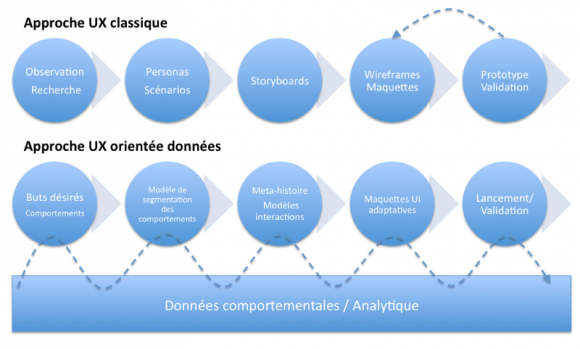
An online shop reconfiguring its settings according to the customer’s profile, buying preferences and patterns, in order to offer the most appropriate experience. An automated teller machine (ATM) whose touch-sensitive interface is adjusting to the customer’s profile and patterns. A hotel mobile app taking into account the place, time, context and customer’s habits in real time to offer highly customized services. Welcome to the wonderful world of customer experience hyper-personalization !
Personalization is not a new concept. For several years now brands have been segmenting and targeting their online customers, adapting their offers, communications campaigns and recommendations towards customers being increasingly challenged, better informed and demanding. But the current trend is to go further, to push such personalization to individual level in adapting content, functionalities and interaction in real time. What is the
aim ? To not merely look for conversion rates and sales growth optimization, but to target more generally customer satisfaction, interactions simplification, brand relevance.
Individual personalization can be reached by systematic collection, real-time analysis and use of a multitude of information regarding the customer and its context.
Today the most mature companies on the subject are interested in knowing everything, at any given time and in real time about every customer taken individually : his mood, state of mind, intentions, where he is (at work, at home, travelling…) ? What is he doing (driving, listening to music, exercising…) ? What device or channel is he using (mobile, web, connected watch…) ? But also a flow of information regarding the context such as the weather, ambient sound level or lighting, not to mention of course his consumption history as a consumer for the brand. But brands are also very well aware that this quest for information has its limits too.
Using personal data also means a risk of privacy infringement.
Where should the red line be drawn ? Various studies show that the consumer is very well aware of the companies’ interest in obtaining all this personal information and that, for the most part, he is unwilling to share the most sensible data, but also that he is rather willing to share a certain amount under the following indispensable conditions :
- full transparency from the brand regarding its intentions ;
- control and management of his preferences in regards to sharing the information he has been unequivocally entrusted with ;
- provided there is a measurable consideration for such sharing.
It’s agive and take. OK to share personal information but the customer experience would have to be outstanding
The customer’s expectations in terms of customer experience personalization are increasingly high. He wants :
- Proactivity : the company must anticipate his needs by prioritizing for example, certain functionalities and certain content or by advising him so he can reach his goal more quickly. For instance, Delta Airlines mobile app – in case of a cancellation or a missed connecting flight, allows you to immediately register again on the next available flight ;
- Relevance : the company has to get rid of the « ambient noise » of irrelevant requests. For example, a website for car spare parts will automatically display parts and accessories that are compatible with the customer’s car brand, model and year ;
- Continuity : the aim is to offer omni-channel experiences and smooth process from a channel to another (web, mobile, tablet computer…) ;
- not to mention an emotional intake by humanizing the relationship as much as possible – e.g. : Frank & Oak, a men clothing startup from Montreal offers his members a customized fashion design service, home delivery of selected clothes according to multiple individual settings and goes even further by including a small personal handwritten note in each package.
ON THE ROAD TO HYPER-PERSONALIZATION !
Hyper personalizing the customer experience entails to rethink (or strengthen) a whole new range of practices within the company regarding process – especially when designing customer experience, its internal organization and technologies to implement. Here below is a brief synthesis of several good practices :
IN TERMS OF PROCESS :
Agility and a step-by-step policy are called for
Building quality customers experiences is no longer sufficient. A brand requires to be outstanding to stand out from competitors, to engage and retain customers. To succeed the company has to go out of its comfort zone, take risks, experiment. Agile methods are then absolutely necessary to produce quick prototypes with short cycles thus allowing to « quickly fail » and then bounce back just as quickly.
Adjust the customer experience’s definition process
A traditional customer experience approach generally begins with research on the user, followed by the creation of user journeys and personas which are then translated into storyboards and wireframes to finally lead to graphic mockups and/or prototypes.
To hyper-personalize customer experience you will need to adapt this classic approach by integrating an analytical component as well as producing flexible user interfaces. It’s called data-driven UX approach. We start with setting out goals to be achieved and aimed behaviors for the target. We then develop a first segmentation for behavior patterns, and for each category, we identify optimal interaction strategies and user experience. Finally we use analytical techniques and machine learning so the system can adapt over time and so the design and underlying interaction patterns can be optimized.

Don’t settle for existing data
To build outstanding personalized customer experiences you should not go from available data to wonder later what you can do with them. On the contrary you should start with determining how you can better individualize each interaction, then determining which data you need and finally asking yourself if such data is available and how to obtain it.
Always have a back-up plan
Predictions from a hyper-personalized system are not foolproof and for that reason, you always need to have a back-up plan. For instance a personalized online shop should always allow the customer to research all the available products from the catalogue, or an ATM’s personalized interface should always provide access to the whole range of services.
IN TERMS OF ORGANIZATION :
To implement successful hyper-personalized approaches, it is essential to :
- suppress silos between the marketing, business and technology departments ;
- strengthen the teams with data profiles : Big Data analysts, Big Data developers, customer experiences designers with analytical skills, etc.
IN TERMS OF TECHNOLOGY :
Create a unified customer view
Most companies manage customer data stored in multiple databases (15 different systems on average according to a Forrester study1 of 200 companies conducted in 2015). This creates significant challenges for the production of a unique customer view and it makes cross-channel marketing actions more difficult to coordinate. A unified customer view is a key issue to address in a proactive manner. The best course of action will be to compile data from « traditional » sources (ERP, CRM, data warehouse…) first and then integrate other customer data sources based on digital architecture.
Use available technology
Customer data consolidation is the first step. You then need to be able to use them and in order to do that, many technological solutions exist. The offer is overabundant and still extremely divided. Before purchasing new products or services it is utterly recommended to first carry a complete inventory of the company’s available tools because there certainly are some. Mapping the existing tools is very beneficial because it allows to quickly highlight the recurrence of some tools that are already implemented (all the functionalities are not always used though) and it helps underpin existing gaps.
Create quick wins and progressively develop more substantial actions
You might be immediately able to create several personalization quick wins with existing content, promptly and with a limited budget, without necessarily aiming for very sophisticated hyper-personalization projects. For instance, Volkswagen France has managed to develop within a few weeks, a real-time personalization app for a campaign offering the testing of vehicles in ten or so sites belonging to the company. Customer data, online (e.g. : online setup for a vehicle) and offline (e.g.: contacting a call center) behaviors are collected with Woopra a tool building dynamic segmentation. This process is followed by sending emails and displaying automated and personalized pop-ins. This is a first step as the company has since then invested in Big Data projects. It collects real time actions initiated by Web users, analyzes these data before comparing them to the behaviors of existing customers. In short, the approach here is to connect behavioral « twins » to later promote dedicated offers.
Define a target architecture and choose missing technology
The aim is to build a robust target architecture and select the various components. Among the hundreds of technologies currently on the market, the main categories to analyze are :
Marketing automation platforms with leads and contacts management at the core of these solutions, the setup of a single customer view integrating information from various sources (from social media to call centers), the integration and synchronization with CRM as well as many other functions : segmentation (up to individual level), scoring, real time behavior monitoring, social listening, etc. The main industry leaders are : Adobe,Oracle, Marketo, Salesforce/Pardot. For the listening platforms2 we will find more specifically the following : Synthesio,Brandwatch, Sprinklr, NetBase…
Web personalization and recommender platforms that are able to understand customer requests, organize results, foresee behaviors and needs, and combine various data sources in order to deliver personalized recommendations and therefore offer the customer more relevant content at the right time. Among them : Marketo, Qubit, SDL,Oracle, Hybris
Data management platforms (DMP) mainly implemented for media optimization (optimization and automation of digital media purchasing, advertising targets segmentations) but which have nonetheless a broader use including also customer experience personalization. DMPs collect, standardize, process and activate the company’s internal and external data. This is the backbone of data-based marketing. The main platforms are : Adobe, Krux, Neustar,Google, Oracle, Eulerian, …
CIAM platforms (Customer Identity & Access Management) also need to be analyzed. Indeed, they enable to find the optimum solution between security and customer experience, produce a 360-degree view of the customer and feed customer analytics. Solutions are : Gigya, Janrain, UnboundID, Stormpath, …
Special guidance from consultants specialized in digital strategy/architecture who also have relevant experience in implementing such tools and solutions, can be very useful to help marketing and technology teams navigate in a field cluttered with technological marketing solutions. They will assist you in building strong architectures to successfully conduct customer experience personalization or hyper-personalization strategies.
- “The Contextual Marketing Imperative: The Evolution Of Personalization From Push Messaging To One-To-One Personal Customer Experiences”, a Forrester Consulting
Thought Leadership Paper, commissioned By SAP hybris (PDF, 203ko) ↩ - Topic already covered in this news section by Frédéric Bon and Stéphane Deschamps in their article « Listening Platforms » : outils indispensables à la rationalisation de votre présence Web ?(in french). ↩





